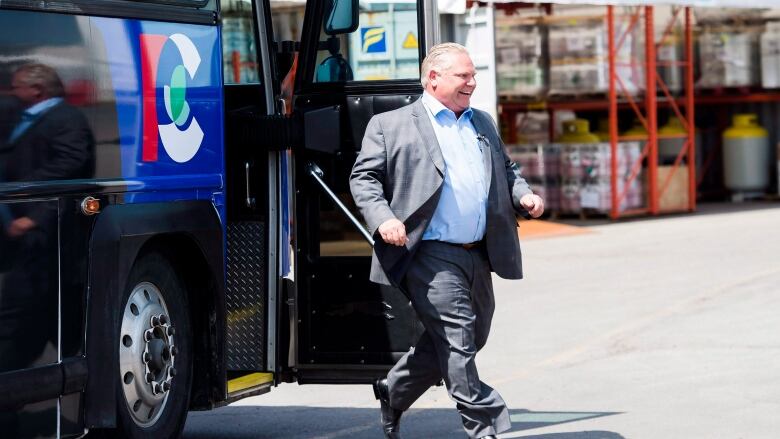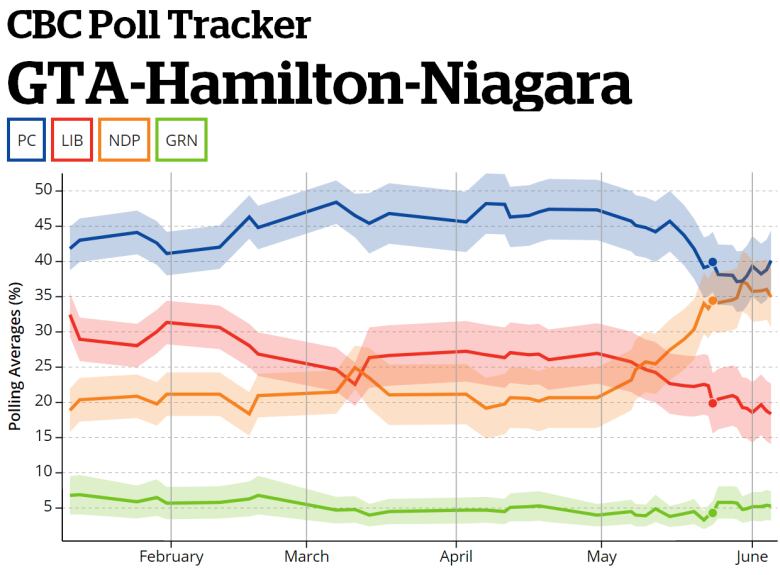Once again, the GTA is poised to play kingmaker in an Ontario election
New Democrats are poised to do well - but the PCs are in a position to do better

If Doug Ford's Progressive Conservatives win a majority government on Thursday, about half of the seats could come from the Greater Toronto Area.
If Andrea Horwath's New Democrats win instead, it will be due to the party scoring adeeper breakthrough inthe region than expected.
As it has in the past,the GTA could be the region that casts the decisive vote in this provincialelection.
The GTA-Hamilton-Niagara region inthis analysis and in the CBC Poll Tracker includes the entire 905 area code, running from Durham to the east of Toronto and along the shore of Lake Ontario down to and including the Niagara Peninsula (but excluding Toronto itself).
It is a massive area, home to 47 of Ontario's 124 seats, with distinctive political battles that vary from region to region. The NDP is poised to win some of thembut the PCs will probably win most.
This would be a significant change from where things stood at dissolution. Along with the Liberal Party's dominance in Toronto itself, the GTA was largely responsible for giving Kathleen Wynne's Liberals a majority government.
Four years later, the party will be lucky to hang on to any ridings in the region.
The Liberal vote has collapsed in the GTA-Hamilton-Niagara region; it'sdown 21 points from the 39 per cent the Liberals captured in 2014. The PCs lead in the region with 40 per cent, up seven points from the last election, while the NDPhas gained 13 points in the polls and sits at 35 per cent.
The Greens follow with five per cent of the vote, unchanged from 2014.
(The Poll Tracker, an aggregation of all publicly available polling data, is updated when new polls are published. See here for the latest numbers.)
But even though the PCs have the edge by about five points, the gap between them and their nearest rivals is a lot closer nowthan it appeared to be at the start of the campaign, when the PCs held a 20-point advantage over both the Liberals and NDP, which were tied for second place in the region.
PC support has fallen about five points in the GTA-Hamilton-Niagara region since then, while the New Democrats have picked up 10 points doubling the number of seats they could winin the area.
Nevertheless, the Progressive Conservatives are still favoured to do very well. They are projected to win between 28 and 37 seats in the region, roughly tripling their performance in the last election.
The NDP's tally could triple as well, to between 10 and 18 seats. The Liberals currently are projected to be in play in only two ridings in the GTA-Hamilton-Niagara region.
Shades of orange and blue
The region's outlook, however, differs from one part of it to another. Some of it could turn a deep shade of orange, while the rest couldflip from red to blue.
The New Democrats are poised to do very well in the Hamilton-Niagara region, where the party won five seats in 2014. But there isn't much for the NDP to gain there that they don't already hold.
Both Brampton and Mississauga could be very closely contested, with virtually every seat in the two cities within range of either the NDPor the PCs. The New Democrats might have the edge in Brampton where they won a seat in 2014, the old riding of federal NDPLeader Jagmeet Singh while the PCs could do well in Mississauga. And in both cities, one or two ridings could vote differently than the others, with the PCs pulling off a few wins in Brampton and the New Democrats picking up a few in Mississauga.
The best hope for the Liberals is to squeak by in a three-way race, but that won't be easy.
Halton and York look likely to flip over to the Progressive Conservatives, while Durham could be a closely-fought race between the NDP and the PCs.
Central Ontario stretching up to Barrie and Georgian Bay looks poised to stick with the PCs.
Looking for efficiencies
As the NDP has surged in the polls and moved into an effective tie with the PCs provincewide, the CBC Poll Tracker seat projection model has consistently givenFord's party a wide advantage. This is due almost entirely to the GTA-Hamilton-Niagararegion.
Even when the NDP has closed the gap entirely with the PCs in the region, the Tories have been projected to win twice as many seats as the NDP. Adding those GTA seats to the ridings the PCs are expected to win in rural Ontario and in Toronto itself has kept the party comfortably in majority territory.
The reason for this is the quilt-like political landscape in the region.
The NDP is projected to do well in Brampton, as the party has more of a base in the city. The party took 22 per cent of the vote or more in every riding therein 2014. About half of the voters in Hamilton's three ridings cast a ballot for the NDPfour years ago, as was the case in the two ridings at the eastern end of the Niagara Peninsula.
This is where the NDP can win seats on Thursday night.
But the NDPtook no better than 16 per cent of the vote in any riding in Mississauga (with the exception of MississaugaMalton, the party's best chance in the city), 14 per cent or less in the Oakville-Burlington ridings and no more than 12 per cent inthe ridings in Markham.
Though they didn't win a seat in the area, the PCs had about twice as much support in Mississauga and nearly three times as much in Markham and Oakville-Burlington. That means the PCs start from a higher base of support. They need less of a jump in these ridings to win them from the Liberals, while the NDPcould gain 20 points or more in some of these seats and still not be in a position to win.
All of this assumes the voting patterns observed in previous elections hold true in 2018. If turnout is significantly different from what it was in 2014, new voters may come out to cast a ballot that would reduce the inefficiency of the NDPvote in the region. That could lead to some unexpected results in a few ridings.
But the Progressive Conservatives are still ahead in the polls and have a history in the GTA it helped deliver a majority government to their federal cousins in 2011. The New Democrats are hoping for a breakthrough, but if the PCs win on Thursday, the GTA will be a big part of thatstory.













_(720p).jpg)


 OFFICIAL HD MUSIC VIDEO.jpg)
.jpg)



























































































